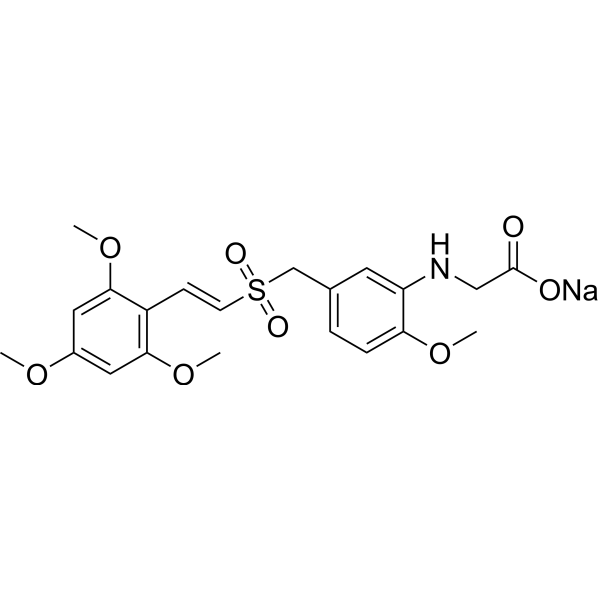| Description: |
Rigosertib (sodium) is a non-ATP-competitive inhibitor of PLK1 with an IC50 of 9 nM, and shows 30-fold selectivity over PLK2. |
| Target: |
PLK1:9 nM (IC50)
PLK2:260 nM (IC50)
PDGFR:18 nM (IC50)
Src:155 nM (IC50)
BCR-ABL:32 nM (IC50)
Cdk1:260 nM (IC50)
Flt1:42 nM (IC50)
Fyn:182 nM (IC50) |
| In Vivo: |
Rigosertib (250 mg/kg, i.p.) markedly inhibits tumor growth in mouse xenograft models of Bel-7402, MCF-7, and MIA-PaCa cells[1]. Rigosertib (200 mg/kg, i.p.) shows inhibition on tumor growth in a mouse xengraft model of BT20 cells[2]. |
| In Vitro: |
Rigosertib is non-ATP-competitive inhibitor of PLK1 with IC50 of 9 nM. Rigosertib also exhibits inhibition of PLK2, PDGFR, Flt1, BCR-ABL, Fyn, Src, and CDK1, with IC50 of 18-260 nM. Rigosertib shows cell killing activity against 94 different tumor cell lines with IC50 of 50-250 nM, including BT27, MCF-7, DU145, PC3, U87, A549, H187, RF1, HCT15, SW480, and KB cells. While in normal cells, such as HFL, PrEC, HMEC, and HUVEC, Rigosertib has little or no effect unless its concentration is greater than 5-10 μM. In HeLa cells, Rigosertib (100-250 nM) induces spindle abnormalities and apoptosis[1]. Rigosertib also inhibits several multidrug resistant tumor cell lines, including MES-SA, MES-SA/DX5a, CEM, and CEM/C2a, with IC50 of 50-100 nM. In DU145 cells, Rigosertib (0.25-5 μM) blocks cell cycle progression in G2/M phase, results in an accumulation of cells containing subG1 content of DNA, and activates apoptotic pathways. In A549 cells, Rigosertib (50 nM-0.5 μM) induces loss of viability and caspase 3/7 activation[2]. Rigosertib sodium (2 μM) induces apoptosis in chronic lymphocytic leukemia (CLL) cells without toxicity against T-cells or normal B-cells. Rigosertib sodium (2 μM) also abrogates the pro-survival effect of follicular dendritic cells on CLL cells and reduces SDF-1-induced migration of leukemic cells[3]. |
| Kinase Assay: |
Recombinant PLK1 (10 ng) is incubated with different concentrations of Rigosertib in a 15 µL reaction mixture (50 mM HEPES, 10 mM MgCl2, 1 mM EDTA, 2 mM Dithiothreitol, 0.01% NP-40 [pH 7.5]) for 30 min at room temperature. Kinase reactions are performed for 20 min at 30°C in a volume of 20 µL (15 µL enzyme + inhibitor, 2 µL 1 mM ATP), 2 µL of γ32P-ATP (40 μCi), and 1 µL of recombinant Cdc25C (100 ng) or casein (1 μg) substrates. Reactions are terminated by boiling for 2 min in 20 µL of 2× Laemmli buffer. Phosphorylated substrates are separated by 18% SDS-PAGE. The gels are dried and exposed to X-ray film for 3-10 min. |
| Cell Assay: |
Cells are grown in either DMEM or RPMI supplemented with 10% fetal bovine serum and 1 unit/mL penicillin-streptomycin solution. Tumor cells are plated into six-well dishes at a density of 1×105 cells/mL/well, and Rigosertib is added 24 hours later at various concentrations. Cell counts are determined from duplicate wells after 96-hour of treatment. The total number of viable cells is determined by trypan blue exclusion. |
| Animal Administration: |
Bel-7402 tumor models: twenty female athymic (NCR-nu/nu) nude mice are injected with 1 × 107 Bel-7402 tumor cells subcutaneously, and 10-14 days later, when the tumor volumes reach 200-250 mm, the mice are divided into four groups such that each group harbors tumors of the same volume. Rigosertib (ON01910, 250 mg/kg) dissolved in PBS is administered alone or in combination with oxaliplatin (100 mg/kg) intraperitonially on alternate days. Tumor measurements are done two times/week using traceable digital vernier calipers. Body weight is determined during each measurement. The animals are observed for signs of toxicity[1]. |
| References: |
[1]. Gumireddy K, et al. ON01910, a non-ATP-competitive small molecule inhibitor of Plk1, is a potent anticancer agent. Cancer Cell. 2005 Mar;7(3):275-86.
[2]. Reddy MV, et al. Discovery of a clinical stage multi-kinase inhibitor sodium (E)-2-{2-methoxy-5-[(2',4',6'-trimethoxystyrylsulfonyl)methyl]phenylamino}acetate (ON 01910.Na): synthesis, structure-activity relationship, and biological activity. J Med Chem.
[3]. Chapman CM, et al. ON 01910.Na is selectively cytotoxic for chronic lymphocytic leukemia cells through a dual mechanism of action involving PI3K/AKT inhibition and induction of oxidative stress. Clin Cancer Res. 2012 Apr 1;18(7):1979-91 |

 To enhance service speed and avoid tariff delays, we've opened a US warehouse. All US orders ship directly from our US facility.
To enhance service speed and avoid tariff delays, we've opened a US warehouse. All US orders ship directly from our US facility.




















